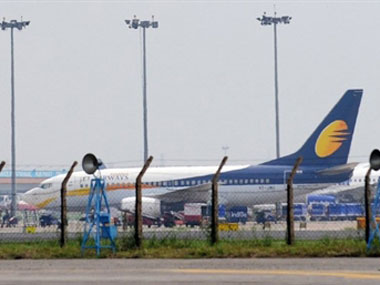New Delhi: Try this for a poser. Air India and Kingfisher have severely curtailed flights. Ticket prices are up. Competition is down. But the remaining airlines are doing worse when they should have been doing better.
Jet Airways, the biggest of the lot, reported a 140 percent increase of losses in the fourth quarter of 2011-12 to Rs 298 crore. SpiceJet’s losses bloated to Rs 249 crore during the same quarter.
Question: why is everyone making more losses when competitors like Air India and Kingfisher have shrunk capacity?
The answer, it seems, is increasing fuel costs. Aviation fuel costs have remained high, and rupee depreciation has worsened the problem because they have to pay more rupees to buy the same quantity of jet fuel. Airlines like Jet Airways and SpiceJet did report better yields (revenue earned per passenger km, or money paid for the ticket divided by the distance travelled) in the March quarter but this was obviously not enough to cut losses.
[caption id=“attachment_327920” align=“alignleft” width=“380” caption=“Why is everyone making more losses when competitors like Air India and Kingfisher have shrunk capacity?Agencies”]
 [/caption]
[/caption]
Also, higher ticket fares were not the reality for the whole quarter (January-March), and the recent spike in fares has dented traffic. So what airlines gained in terms of yield they lost in terms of slowdown in traffic growth.
March saw the slowest growth in passenger traffic at 1.1 percent to 4.87 million passengers. So it is myth that air traffic has increased each month this year. March traffic growth was the worst since May 2009 - the bottom of the global slowdown - when traffic growth declined by 4.4 percent. For the entire quarter, traffic increased by just 6.55 percent to 15.3 million.
Impact Shorts
More ShortsSo if airlines say they are slipping further into losses, its happening because growth in passengers was perhaps the lowest in January-March this year and March was particularly bad.
The Centre for Asia Pacific Aviation (CAPA) estimates Indian carriers together lost $2.5 billion in the 12 months ended 31 March. This is on total revenues of just under $10 billion - a worse result than even 2008-09, when traffic was declining and fuel prices spiked at $150 a barrel. Again, the depreciating rupee is the biggest culprit.
The financial health of the three listed Indian carriers is delicate, as their quarterly results show. A Kingfisher Airlines statement said on Thursday morning that fuel prices increased by over 40 percent in FY12 over the previous year and the situation was further compounded by a weakening rupee. “The industry’s demand growth in the domestic market, at 13 percent in FY12 over the previous year, was overshadowed by a 17 percent growth in industry capacity, leading to pressure on yields and the load factor for the industry.”
Kingfisher lost Rs 1,150 crore in the March quarter, three times as much as the Rs 356 crore losses of the year before. Revenue fell 54 percent to Rs 740 crore. In short, Kingfisher’s losses now dwarf its turnover.
For the country’s largest airline group, Jet Airways, the March quarter loss widened to Rs 298 crore from Rs 124 last year and the airline squarely blamed a weak rupee, which further pushed up the fuel bill, neutralising the 24 percent growth in revenues. Domestic market yields grew by just 3-3.5 percent. During the quarter, fuel costs surged 26 percent to Rs 307.7 crore and the rupee depreciated by over 14 percent to Rs 50.8 against the dollar.
The company incurs 60 percent of its expenses in dollar. But revenue growth came straight from improved seat factor which stood at 79 percent. Roughly translated this means only one in five seats went empty for the airline in the March quarter. Jet’s domestic passenger growth was a healthy 31 percent.
SpiceJet also followed peers with net loss widening to Rs 249 crore for the March quarter against a loss of Rs 59 crore for the comparable previous period. However, the airline has generated 18 percent growth in passenger yields at Rs 3,816 from Rs 3,237 in the corresponding previous period.
Both SpiceJet CEO Neil Mills and Jet Airways officials have indicated that the results for the current quarter (April-June) should be better than the March quarter, but then the rupee slide has continued unabated.
Sunny Sodhi, Vice-President (Airlines and Corporate Business) at yatra.com , says June quarter results would make for interesting reading. “We understand yields are high now but the rupee depreciation has kept pace too. The only positive for the domestic industry is load factor, which is a high 85-86 percent now against the earlier average of 75-78 percent.”
In the last two months, domestic yields have increased by about 20 percent. A one-way Mumbai-Delhi ticket for Friday on low-fare carriers like GoAir, IndiGo, SpiceJet is a steep Rs 8,000 whereas it is Rs 10,473 on a Jet Konnect flight and Rs 9,283 on a Jet flight. Gone are the days when you could do a return journey for this amount.
)